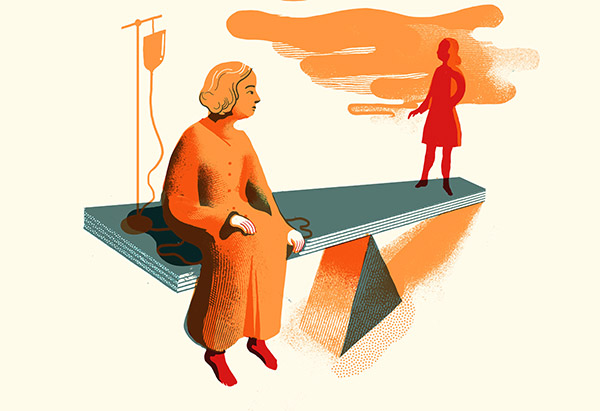A Leading Cause of Death You Don't Even Know About
To survive sepsis—the 11th leading cause of death in this country—you need to catch it early. But many patients don't even know what it is.

Illustration: Raphael Urwiller
The woman in the ICU bed was almost unrecognizable. Her chest rose and fell mechanically, her eyes screwed shut in something between sleep and death. Her arms were puffy from fluid that her kidneys would normally carry away but that instead leaked from her cells and accumulated under her skin. Her beautiful straight nose, the one I wish I'd inherited, was mashed to one side by the tape holding the tube in her mouth, which connected to the ventilator breathing for her.
It was my 76-year-old mother in the bed, and she was dying of sepsis, a disease I'd never heard of—a disease she may not even have had when she came to the hospital six days earlier, complaining of abdominal pain.
Each year more than one million Americans develop sepsis, a systemic response to even the tiniest infection in which a devastating cascade of inflammation races through the body, potentially leading to organ failure. It tends to strike those over 65 and people with weakened immune systems. It's common among hospital patients, who pick up pathogens through IV lines or catheters. But anyone is susceptible.
If caught early, the syndrome is treatable with heavy-duty antibiotics. The trouble is, there's no single diagnostic test. And while sepsis is common, doctors often miss it until it's too late, which helps explain why 20 to 60 percent of those who develop sepsis die from it.
My mother's doctor initially thought her stomach pain was caused by scar tissue from an earlier operation, and took a wait-and-watch approach. But by day five of her hospital stay, the pain had worsened, her breath came quick and hard, her blood pressure dropped, and she became confused. Exploratory surgery revealed nothing.
Next: The diagnosis no one had considered
It was my 76-year-old mother in the bed, and she was dying of sepsis, a disease I'd never heard of—a disease she may not even have had when she came to the hospital six days earlier, complaining of abdominal pain.
Each year more than one million Americans develop sepsis, a systemic response to even the tiniest infection in which a devastating cascade of inflammation races through the body, potentially leading to organ failure. It tends to strike those over 65 and people with weakened immune systems. It's common among hospital patients, who pick up pathogens through IV lines or catheters. But anyone is susceptible.
If caught early, the syndrome is treatable with heavy-duty antibiotics. The trouble is, there's no single diagnostic test. And while sepsis is common, doctors often miss it until it's too late, which helps explain why 20 to 60 percent of those who develop sepsis die from it.
My mother's doctor initially thought her stomach pain was caused by scar tissue from an earlier operation, and took a wait-and-watch approach. But by day five of her hospital stay, the pain had worsened, her breath came quick and hard, her blood pressure dropped, and she became confused. Exploratory surgery revealed nothing.
Next: The diagnosis no one had considered
As a reminder, always consult your doctor for medical advice and treatment before starting any program.



